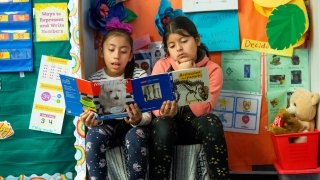For almost 30 years, I have worked as a teacher or alongside teachers who work closely with students identified as English Learners (ELs). Most recently, I have focused on supporting secondary teachers at the middle and high school level in meeting the language and content needs of their students.
I often get asked about the role of diverse content-area teachers in supporting ELs. There is a misconception that ELs need only strong English language development (ELD) and English language arts (ELA) instruction, and the work of supporting ELs is left to the ELD and ELA teachers. While explicit language instruction is taught in ELD and ELA, and students develop strong language skills from schools that prioritize designated classes in ELD and differentiated instruction in ELA, the work of supporting ELs relies on all teachers.
Recognize the language opportunities in content instruction
Language is a part of all content instruction and is directly connected to the thinking skill and content that students will use and learn during a lesson. The subject matter at hand drives the vocabulary they will need to make meaning of new content and express what they have learned. Teachers must anticipate how the thinking skill guides what language support ELs might need.
For example, students may be asked to describe or compare systems of the body, or evaluate the efficiency of a system based on diet. The thinking skill needed for each task equates to a language function, or the purpose for using language in a scenario. If students are asked to compare body systems, they will need comparative language. If they are going to evaluate body systems, they will need the language of evaluation. Knowing the language function allows teachers to select a range of sentence frames or syntactic cues to guide students’ production of language when they share what they have learned. Once we can identity the thinking skill and the content for a lesson, we can identify core language support ELs may need to access the content and express what they’ve learned.
Recognize the diversity of English Learners
California has a long history of leading efforts in how we educate ELs. With the largest EL population in the nation—35% of the overall K–12 population—myriad guidelines and resources have been developed to support teachers working with ELs. In 2020, the California Department of Education released a research-to-practice guide, “Improving Education for Multilingual and English Learner Students,” which reminds us of the importance of getting to know multilingual learners to best serve their needs. This means getting to know ELs as individuals.
The EL population is a subset of multilingual learners, who enhance the language and cultural diversity of our classrooms. Within the EL group there is great diversity and a variety of experiences that impact students’ needs. For example, a high school-level EL who is new to this country and may have had interrupted schooling in their home country has different needs from an EL who has been in U.S. schools since kindergarten. I have seen an average of eight typologies identified within the EL population, yet they are all given a generalized label of “English Learner.” The needs of this group are vast and cannot be limited to a label that only captures the commonality that they are developing two or more languages. When you learn a strategy as a teacher for supporting ELs, you want to ask yourself, Which need is it meeting, and is that aligned with the needs of the language learners in your class?
Let them talk!
The beauty of having a diversity of ELs in our classrooms is the opportunity for them to learn language from one another. If there is one thing I want to leave you with, it is to let them talk. Too often I walk through secondary classrooms that are quiet, with students completing independent tasks. Students cannot build fluency in a new language if we do not provide them with opportunities to use the language. Think about your own experiences learning a new language. If you had opportunities to study the language, write and read about it, but never used it regularly, you were not able to communicate fluently. It is that old cliche that you take foreign language classes in high school for four years but when you visit a country that speaks the language you studied, you find that you are not able to hold a conversation. I wonder, did you get enough opportunities to practice using the language? The same holds true for secondary ELs. If they are going to develop the ability to share what they are learning across all content areas, they need ample opportunities to use language in every class.
To learn more about Professor Mora-Flores’ research on English Learners, check out her new book, co-written with Stephanie Dewing, Teaching and Supporting English Learners: A Guide to Welcoming and Engaging Newcomers.





